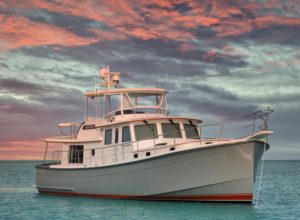 Most of you, when you read this, will likely have been operating your Krogen Express, 49’, 52’, or 53’, for quite some time. However, having accumulated a combined probably 7500 or 8000 hours aboard, we think we might have some insight that would be useful.
Most of you, when you read this, will likely have been operating your Krogen Express, 49’, 52’, or 53’, for quite some time. However, having accumulated a combined probably 7500 or 8000 hours aboard, we think we might have some insight that would be useful.
First, we think of the boat as having two primary sweet spots. Unless there are speed restrictions, we’re either running in the low 9s (knots) or above 15. Most of the time for us it’s at the slower speeds in part to conserve fuel but also because we just flat out enjoy life on the water at a more relaxed pace.
You’re probably aware that hull speed for our boats is between 9.4 knots (for 49s) and 9.6 knots (for 52s/53s). For those of you with higher speed engines (Yanmars or Cummins), you’re probably running around 1600 rpms to get in the low 9 knots. That tends to be our default operating mode. The RPMs for Cats will differ slightly and, if your boat has been re-propped, may also vary.
From our point of view, trying to run any faster than hull speed, without getting up to 15 kts., is very inefficient, so we try to avoid it. If you have digital engine instrumentation or FloScans, you can watch the fuel consumption go up exponentially as you try to climb the hump, only to gain a knot or so.
Something to observe is that at anything below your hull speed, the boat runs flat with no perceptible bow rise. You know then, that you’re in “displacement mode” and running efficiently.
Of course, you can slow down further if you want and run at 8 knots or less. You’ll definitely save fuel but you’ll want to take extra care that your engines are fully up to temperature. While it’s ok to run modern diesels at lower engine speeds, running them too cool can shorten their life.
At displacement speeds we don’t use the tabs. Keep them all the way up. Lowering them will only cause drag.
When you want to go faster, drop the tabs all the way down and then push your throttles forward. We tend to be relatively aggressive when we do this to get “over the hump” quickly. Why? Two reasons. We want to get through the inefficient, “climbing the hump” range fairly quickly and we want the bow to come back down so we can see where we’re going. At this point, to be efficient, you’ll want to be above about 15 knots to keep your Krogen Express “up on plane”.
Our practice, with the Yanmars, is to run the engines at around 2650-2700 rpms. At much lower RPMs, certainly below 2600, we find the boat wants to start slowing down as the bow comes up. While we are usually happy at that 15-16 kt. speed, some of you out there do tend to run in the 17-18 kt. zone and the boat can certainly do that.
Both Yanmar and Cummins say their engines can be run safely, continuously, at 3000 to 3100. So if you’re really needing to make time and you’re willing to burn some fuel, go for it.
If you’re like us, and you’re running most of the time at lower speeds, most engine manufacturers highly recommend running once a day, for 15 or 20 minutes, at 80% of rated rpm (2700 on Yanmar and Cummins QSB6.7, both of which are 3300 rpm engines). This ensures that everything in the engine gets fully up to temperature and essentially helps to clean it out. You’ll get longer life out of your engines if you do this.
It’s also recommended that you run your engines at WOT (Wide Open Throttle) periodically. I’d suggest once a month or so, but at least quarterly. You really only need to do this for 10 minutes or so. You’re wanting to make sure both engines turn up past rated RPM (over 3300 for Yanmar and Cummins) and that temperatures and pressures reach a plateau within the acceptable range. This is recommended as it can be an early warning if something is going wrong and generally just gives peace of mind that everything in your propulsion system checks out. If the rpms don’t hit the target or the temps/pressures are not stable, time to get it checked out! Whatever you find (hopefully nothing), consider taking a picture of the display for both engines and capture it in your log.
 Questions or comments? We’d love to hear them, so please send them our way or post in the comments below. And happy cruising!!
Questions or comments? We’d love to hear them, so please send them our way or post in the comments below. And happy cruising!!

We have 3116 Caterpillar engines. What is the recommended rpm’s for a 30-to 50 mile run, and where should our temperature readings be +/_? I’m using only the recommended cat oils for these engines. so far my temperature readings during a cruise have been in the 210- 215 degrees range. The gauges read much lower than those numbers: closer to 190-195 degrees.
thanks in advance
Hank